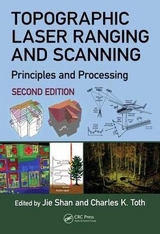
Topographic Laser Ranging and Scanning
Crc Press Inc (Verlag)
978-1-4200-5142-1 (ISBN)
- Titel erscheint in neuer Auflage
- Artikel merken
A systematic, in-depth introduction to theories and principles of Light Detection and Ranging (LiDAR) technology is long overdue, as it is the most important geospatial data acquisition technology to be introduced in recent years. An advanced discussion, this text fills the void.
Professionals in fields ranging from geology, geography and geoinformatics to physics, transportation, and law enforcement will benefit from this comprehensive discussion of topographic LiDAR principles, systems, data acquisition, and data processing techniques. The book covers ranging and scanning fundamentals, and broad, contemporary analysis of airborne LiDAR systems, as well as those situated on land and in space. The authors present data collection at the signal level in terms of waveforms and their properties; at the system level with regard to calibration and georeferencing; and at the data level to discuss error budget, quality control, and data organization. They devote the bulk of the book to LiDAR data processing and information extraction and elaborate on recent developments in building extraction and reconstruction, highlighting quality and performance evaluations. There is also extensive discussion of the state-of-the-art technological developments used in: filtering algorithms for digital terrain model generation; strip adjustment of data for registration; co-registration of LiDAR data with imagery; forestry inventory; and surveying.
Readers get insight into why LiDAR is the effective tool of choice to collect massive volumes of explicit 3-D data with unprecedented accuracy and simplicity. Compiled by leading experts talking about much of their own pioneering work, this book will give researchers, professionals, and senior students novel ideas to supplement their own experience and practices.
Purdue University, West Lafayette, Indiana, USA Ohio State University, Columbus, USA
Introduction to Laser Ranging, Profiling, and Scanning, G. Petrie and C. K. Toth
Airborne and Spaceborne Laser Profilers and Scanners, G. Petrie and C. K. Toth
Terrestrial Laser Scanners, G. Petrie and C. K. Toth
LiDAR Systems and Calibration, A. Wehr
Pulsed Laser Altimeter Ranging Techniques and Implications for Terrain Mapping, D. Harding
Georeferencing Component of LiDAR Systems, N. El-Sheimy
Waveform Analysis for Small-Footprint Pulsed Laser Systems, U. Stilla and B. Jutzi
Strip Adjustment and Registration, C. K. Toth
Accuracy, Quality Assurance, and Quality Control of LiDAR Data, A. Habib
Management of LIDAR Data, L. Graham
LiDAR Data Filtering and DTM Generation, N. Pfeifer
Forest Inventory Using Small-Footprint Airborne Lidar, J. Hyyppä, H. Hyyppä, X. Yu, H. Kaartinen, A. Kukko, and M. Holopainen
Integration of LiDAR and Photogrammetric Data: Triangulation and Ortho Rectification, A. Habib
Feature Extraction from Lidar Data in Urban Areas, F. Bretar
Building Extraction from LiDAR Point Clouds Based on Clustering Techniques, J. Shan and A. Sampath
Building and Road Extraction by LiDAR and Imagery, F. Rottensteiner and S. Clode
A Data-Driven Method for Modeling 3D Building Objects Using a Binary Space Partitioning Tree, G. Sohn, X. Huang, and V. Tao
A Framework for Automated Construction of Building Models from Airborne LIDAR Measurements, K. Zhang
Quality of Buildings Extracted from Airborne Laser Scanning Data: Results of an Empirical Investigation on 3D Building Reconstruction, E. Gülch, H. Kaartinen, and J. Hyyppä
Index
| Erscheint lt. Verlag | 18.11.2008 |
|---|---|
| Zusatzinfo | 8 pages, 14 figures; 237 equations; 39 Tables, black and white; 376 Illustrations, black and white |
| Verlagsort | Bosa Roca |
| Sprache | englisch |
| Maße | 178 x 254 mm |
| Gewicht | 1268 g |
| Themenwelt | Technik ► Bauwesen |
| ISBN-10 | 1-4200-5142-3 / 1420051423 |
| ISBN-13 | 978-1-4200-5142-1 / 9781420051421 |
| Zustand | Neuware |
| Haben Sie eine Frage zum Produkt? |
aus dem Bereich



